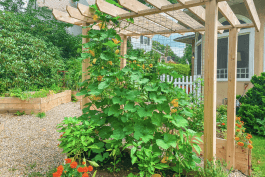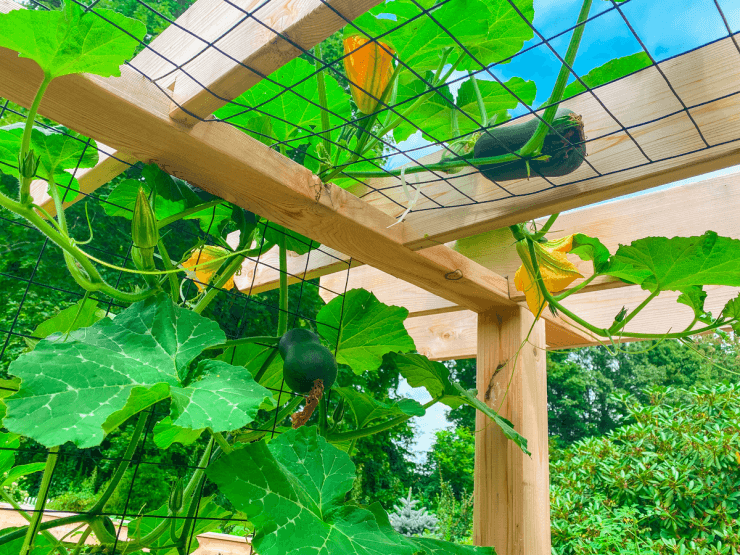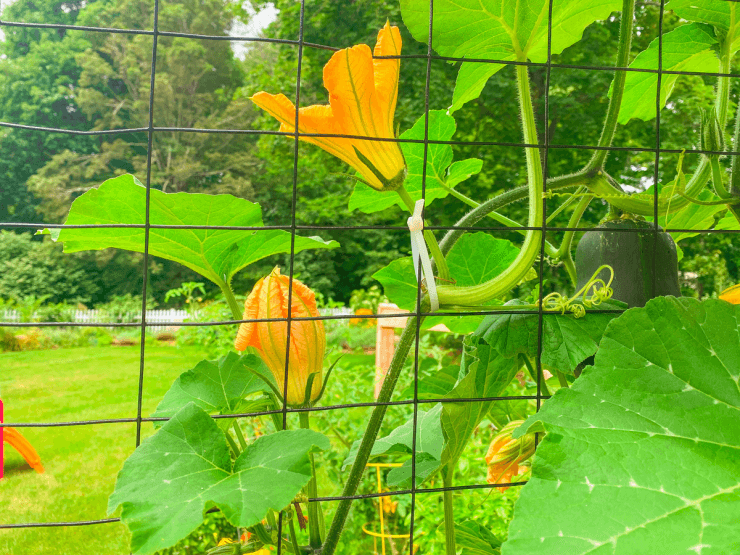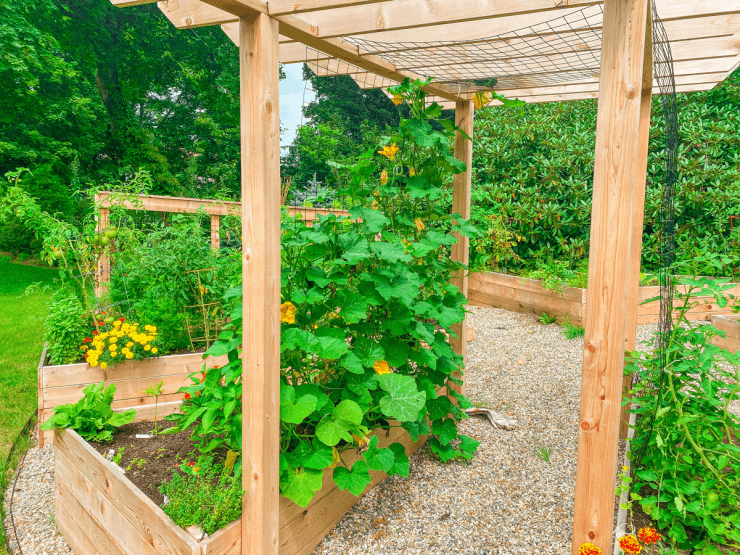
If you’ve been looking for a way to grow more squash in your vegetable garden, but don’t have the space or time for lots of plants growing every which way they please, then you should know how to train squash to grow vertically. It’s easy and it will help maximize your space without sacrificing yield. Plus, squash and trellises are basically made for one another. Squash vines are vigorous, they love to sprawl out and they need support on which to climb. A trellis provides both of these benefits plus the added bonus of letting in plenty of light during the summer months while giving them room to breathe, which can help with powdery mildew. Plus, they look pretty cool growing too, which is always a plus.
When I built my new garden this year, I imagined a big lush trellis covered in squash and melons. Unfortunately, my melons never took off this year, but my adorable Honeynut squash did great and is making up for it. They were off to a slow start, like just about everything else this year for those of us in New England who had an ultra-wet sunless start to the summer. However, all I had to do was leave for a week on vacation, and I came back to some vines sprawling off the side of the bed.

Why not up the trellis, which they were planted right below, you might ask? Well, you can’t just set it and forget it if you want to learn how to train squash up a trellis, you’ll need to give it a little guidance at first. Here’s how to do it, from beginning to end:
- Start with a sturdy trellis that is at least 5 feet tall and attach it to an existing fence, wall, arbor, or raised garden bed with good drainage.
- Add organic compost to the soil and plant 2 seeds in a mound about two feet apart for the length of your trellis.
- Water regularly and keep weeds away from plants by mulching or using an organic weed barrier such as straw or hay.
- As the squash grows, train it up the trellis by weaving it in and using zip ties, plant ties, or string to loosely secure the squash around the forks in the stems. From there, the tendrils will begin to attach and grow upward on their own.
- Note: If you had a boom in growth while away (or on vacation like I did) where your plant put down some additional roots, you can still gently pull any roots and vines up and follow the same process.
- Harvest when the fruit is mature by cutting off the vine just below each fruit – don’t wait for all of them to ripen at once, and harvest your winter squash before frost arrives!
- Store in a cool, dry place (such as your garage) until you’re ready to use.
When the vines start to climb up the trellis, they’ll naturally twine around each other so there’s no need for any additional tying, you may actually be able to remove the ties after a couple of weeks if you want to.
If you are building a new trellis for this purpose, you might also want to use larger squares than I have. I have seen ones with squares for the squash to weave through that are 6-8″ which seem like they’d work better with the large leaves. However, it’s also working just fine with my little rectangles, and the wire is certainly strong enough to support it, which is the most important thing of all.

A few vegetables that grow easily up a trellis because they have little grabby arms that help are:
- Summer Squash
- Cucumbers
- Runner Beans
- Peas
- Melons
You can also grow vining tomatoes up a trellis, and in fact, I did that this year too. You’ll just need to use tomato clips or zip ties because they just grow everywhere, they don’t attach themselves to anything. It keeps them from growing into the ground or snapping at the top of your tomato trellis from too much weight.

How to keep your squash plants happy
To grow lots of squash, your plant will appreciate a little potassium and phosphorus. The fertilizer I prefer for squash is a balanced 5-5-5 blend.
Signs of trouble to look out for:
Slugs! Usually growing up a trellis helps tremendously with slugs because so much of your plant is off the ground, however, they can still attack the root and bottom leaves. If you leave a little cup of beer out, slugs love a little pub crawl and will get right in and ultimately drown. This is the most effective slug trick I’ve tried.
Squash bugs are another known pest, and you can avoid them from the start. When your plants are small, sprinkle diatomaceous earth around the base of each plant. Then just reapply after every rain. This will basically dry out any bugs, like squash bugs, that have a shell before they have a chance to murder your plants.
If your leaves begin to go yellow, they may just need a little boost of nitrogen. However, don’t add nitrogen unless you see this issue happening to more than just one leaf because too much nitrogen is a problem too. If you are producing lots of healthy leaves and no flowers or fruit, you may have too much nitrogen in your soil and that’s worse than a few yellow leaves. To reduce nitrogen, add mulch, which will absorb the nitrogen as it breaks down.
There are many things you can do to make your garden more productive, but one of the easiest and most rewarding is growing squash up a trellis. It’s not only better for the squash because it gives them lots of room to grow, but also has benefits like reducing pest problems by keeping leaves off the ground and gives them lots of room to sprawl so they produce more fruit than if they were planted in the ground. The plants also seem healthier because their roots are exposed to air rather than being buried underground. I’m still experimenting with how much space each plant needs when growing up versus down; so far my favorite is about two feet apart.
Will you try growing your next batch of squash on your own trellis? Or maybe even a few ladders stacked together? Let me know! I would love to hear about any other gardening tips or tricks that have worked well for you.


 Previous
Previous


Can you get a zucchini squash to grow vertically?
Yes – you can definitely grow zucchini vertically. Just make sure to secure it well and watch out for windy areas – any vertical crop is a bit more susceptible to damage from wind.
I use cattle panels 16’ long. I have 10’ span and just put one end down inside the bed on one end and curve it over the length of the bed and into the frame at the other end. Works great and is not fastened to the bed so can be moved to a different location easily if you crop rotate or don’t plant vines anther year. I used for squash and bean vines this year. The height isn’t so high I can’t reach and trim leaves for air movement either.
Two things that are good to know about diatomaceous earth are that: a) it works by dehydrating any bugs and pests that consume it from the inside; and b) there are two types. One sort is food grade – it can be used by humans for medicinal purposes. The other is not. It’s not safe for human consumption, and probably not for your pets, either. I would unquestionably use the food grade variety.
What is the name of the spray bottle you used for the leaves?
My favorite garden spray bottle is the Zep Commercial 32 oz. Pro Sprayer. I like the size and the measurements on the side of the container.
I have never been able to grow healthy squash. Something always attacks the root. I may get one or two off the plant, and then it’s done. I grow in pots and always try to train my plants to grow up. What other plants do I see in your box, and what are the benefits of growing them with your squash?
Marigolds go in many of the planters – they’re great for natural pest control and they look pretty!
We make wire cages with cattle fencing, I’ve been growing spaghetti and butternut squash in those cages for the last 4 years. It works great. I just wind the squash vines around the cage until they get to the top and then just let them go.